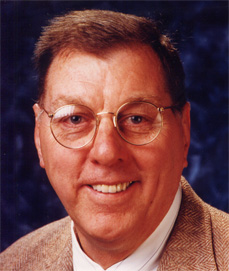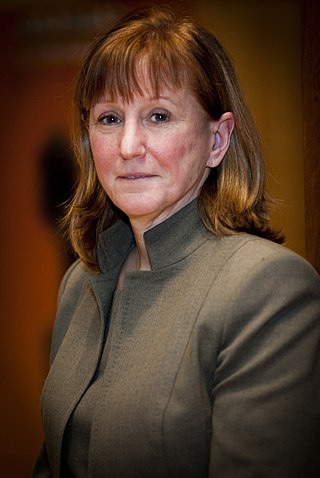
Nanotechnology education involves a multidisciplinary natural science education with courses such as physics, chemistry, mathematics, and molecular biology. It is being offered by many universities around the world. The first program involving nanotechnology was offered by the University of Toronto's Engineering Science program, where nanotechnology could be taken as an option.

Amy Gutmann is an American academic and diplomat who has served as the United States Ambassador to Germany since 2022. She was previously the president of the University of Pennsylvania from 2004 to 2022, the longest-serving president in the history of the University of Pennsylvania.

Nader Engheta is an Iranian-American scientist. He has made pioneering contributions to the fields of metamaterials, transformation optics, plasmonic optics, nanophotonics, graphene photonics, nano-materials, nanoscale optics, nano-antennas and miniaturized antennas, physics and reverse-engineering of polarization vision in nature, bio-inspired optical imaging, fractional paradigm in electrodynamics, and electromagnetics and microwaves.

Michael S. Tomczyk is best known for his role in guiding the development and launch of the first microcomputer to sell one million units, as Product Manager of the VIC-20 from Commodore. His contributions are described in detail in his 1984 book, THE HOME COMPUTER WARS: An Insider's True Account of Commodore and Jack Tramiel. His role is also documented extensively in numerous interviews and articles. The VIC-20 was the first affordable, full-featured color computer and the first home computer to be sold in KMart and other mass market outlets. Michael joined Commodore in April 1980 as Assistant to the President. He has been called the "marketing father" of the home computer. Michael was also a pioneer in telecomputing, as co-designer of the Commodore VICModem, which he conceived and contracted while at Commodore. The VICModem was the first modem priced under $100 and the first modem to sell one million units.

The University of Pennsylvania School of Engineering and Applied Science is the undergraduate and graduate engineering school of the University of Pennsylvania, a private research university in Philadelphia. The school offers programs that emphasize hands-on study of engineering fundamentals while encouraging students to leverage the educational offerings of the broader University. Engineering students can also take advantage of research opportunities through interactions with Penn’s School of Medicine, School of Arts and Sciences, and the Wharton School.

Chad Alexander Mirkin is an American chemist. He is the George B. Rathmann professor of chemistry, professor of medicine, professor of materials science and engineering, professor of biomedical engineering, and professor of chemical and biological engineering, and director of the International Institute for Nanotechnology and Center for Nanofabrication and Molecular Self-Assembly at Northwestern University.
The College of Nanotechnology, Science, and Engineering is part of the University at Albany, SUNY in Albany, New York. Founded in 2004 at the University at Albany, SUNY, the college underwent rapid expansion in the late-2000s and early-2010s before merging with the SUNY Institute of Technology in 2014. The college rejoined the University at Albany in 2023. The college was the first college in the United States devoted to nanotechnology.

Joseph M. DeSimone is an American chemist, inventor, and entrepreneur who has co-founded companies based on his research, including the American 3D printing technology company, Carbon, of which he was CEO from 2014 until November 2019.

John A. Quinn was the Robert D. Bent Professor Emeritus of Chemical and Biomolecular Engineering at the University of Pennsylvania School of Engineering and Applied Science. He was a leader in the fields of mass transfer and membrane transport in synthetic membranes since the 1960s. In the early phase of his career at the University of Illinois, Quinn and his students devised simple, elegant experiments to elucidate the role of the interface in mass transfer between phases. In later work at Penn, he applied these insights to problems of engineering and biological significance involving chemical reaction and diffusion within and through both finely porous and reactive membranes. His chemical engineering science has informed matters as far afield as the separation of chiral pharmaceuticals and the behavior of cells at interfaces.

Chinedum Osuji is the Eduardo D. Glandt Presidential Professor and the departmental chair of chemical and biomolecular engineering (CBE) at University of Pennsylvania. He is also a former Taekwondo Olympian and represented Trinidad and Tobago. His laboratory works on polymers and soft materials for functional application including liquid filtration. He is the associate editor of the journal Macromolecules.
Alan T. Charlie Johnson is an American physicist and a professor in physics and astronomy at the University of Pennsylvania. Johnson currently serves as the founding executive editor of the scientific journal AIP Advances and the co-founder of Graphene Frontiers, LLC.
Cherie R. Kagan is the Stephen J. Angello Professor of Electrical and Systems Engineering, Professor of Materials Science and Engineering, and Professor of Chemistry at the University of Pennsylvania. Kagan is an Associate Editor of ACS Nano and serves on the editorial boards of Nano Letters and NanoToday.

Carl H. June is an American immunologist and oncologist. He is currently the Richard W. Vague Professor in Immunotherapy in the Department of Pathology and Laboratory Medicine at the Perelman School of Medicine of the University of Pennsylvania. He is most well known for his research on T cell therapies for the treatment of several forms of cancers. In 2020 he was elected to the American Philosophical Society.
Kathleen Stebe is a scientist with areas of expertise in Nanostructured Materials, as well as Surface and Colloidal Science. She is also a Professor of Chemical and Biomolecular Engineering at The University of Pennsylvania.

Dawn Austin Bonnell is the Senior Vice Provost for Research at the University of Pennsylvania. She has previously served as the Founding Director of the National Science Foundation Nano–Bio Interface Center, Vice President of the American Ceramic Society and President of the American Vacuum Society. In 2024, she was elected to the American Philosophical Society.
Katrina Alison Armstrong is an American internist. She is the chief executive officer of the Columbia University Irving Medical Center and Dean of the Faculties of Health Sciences and the Columbia University Vagelos College of Physicians and Surgeons. Armstrong is the first woman to lead Columbia's medical school and medical center. She was the first woman to hold the position of Physician-in-Chief at Massachusetts General Hospital and was elected to the National Academy of Medicine in 2013 and the American Academy of Arts and Sciences in 2020.

Rinad S. Beidas is an American clinical child psychologist and implementation scientist. She is currently the chair and Ralph Seal Paffenbarger Professor of the department of Medical Social Sciences at the Northwestern University Feinberg School of Medicine. She was formerly professor of Psychiatry and Medical Ethics and Health Policy at the Perelman School of Medicine at the University of Pennsylvania; Director of the Penn Implementation Science Center (PISCE@LDI); and Director of the Penn Medicine Nudge Unit. She is currently an Associate Director at the University of Pennsylvania's Center for Health Incentives and Behavioral Economics.

Duygu Kuzum is a Turkish-American electrical engineer who is a professor at the University of California, San Diego's Jacobs School of Engineering. She develops transparent neural sensors based on single-layer materials. She was awarded a National Institutes of Health New Innovator Award in 2020.

















